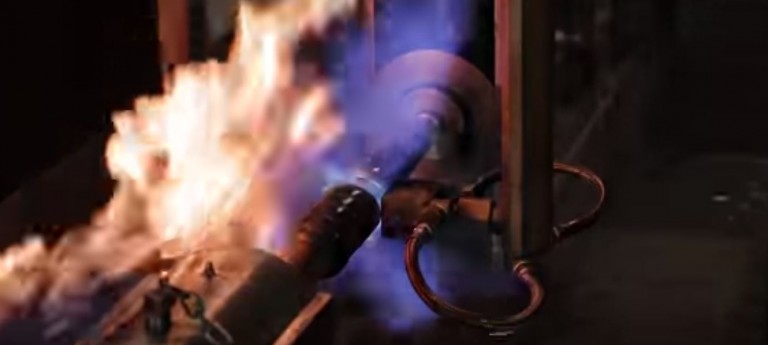Just Throw Some Heat At It

Since a blog is usually some way for the author to try and educate readers about some topic, let’s start the New Year with busting some widely held misconceptions about heat treating in general, and flame hardening in particular.
Very often larger companies have inhouse staff engineers responsible for figuring out the machinery needed to process parts throughout the production line. These P.E.’s usually have good mechanical and spatial skills, but invariably lack the specialized knowledge of heat treating. We have heard more than once, after being called in to redesign a process that couldn’t be salvaged, the engineers didn’t think the heat treating process was that complicated. “You’re just throwing some heat at it,” we’ve heard again and again.
Let’s break that misconception down.
First, that part about throwing. Many engineers don’t take into account the mechanism by which heat is transferred to a steel or cast iron part. They may be accustomed to thinking of heat treating as just putting a part in an oven, or putting a welding torch to it and a hose. You can “throw” heat at something that way, but the real question is, what sort of part do you want to produce? Do you want a part that’s been over treated in an oven, causing distortion and then taking up more manufacturing time for the machining necessary to remove what’s out of tolerance? Do you want parts that, because they were manually heated with a torch and quenched with water at whatever temperature comes out of a hose, are impossible to produce consistently with a reliable pattern? Is that good enough for your customers? Is it good enough for you?
So now we’re at the part of “some heat.” Heat treating encompasses a wide variety of options, from the welding torch to induction coils to carburizing to tempering to controlled flame hardening, and each has a specific application for which it’s best suited. But before you can determine the type of heat to use, you need to know why you’re hardening the part and to what depth and pattern. That information arises from how the part needs to perform in the field. It should tell you how much of the part actually needs heat treating, and at what temperature based on your material, and at what depth – THEN you are ready to start engineering a solution that takes into account the type of heat best suited for your needs, and that in turn determines the spatial relationships between the heat source, the part being treated, and the rest of the workings of the machine.
For example, once we have designed the loading mechanism and treating station in a flame hardening machine, we now have what we call a “sphere of heat” into which no other machine hoses, gears, belts, or wiring can be placed. The design of the machine “throws heat” at the part by focusing it at the area needing treatment and no other. It has to produce that amount of heat, at that temperature, at the correct spatial relationship to the part, for exactly the same amount of time, time and time again. That’s how we approach flame hardening in production environments. You could say we’re throwing some heat, but before that we’re identifying the size of the heat, the amount and time of the heat, and setting all the variables of the system that controls the heat.
Many P.E.’s also forget that it’s not just about the heat, it’s also the cool. Quench is an essential aspect of localized hardening – hardening that forces heat into one area of a part so as not to subject it to too much heat, risking distortion. The heated area needs cooling at a particular rate to achieved the desired hardness level and in some cases also the depth. So quench may need to be heated or cooled, agitated, and definitely contained so that it’s not splashing onto other parts of the machine or on operators. This is an extremely important and often overlooked aspect of localized hardening. To achieve a 55 Rockwell at a depth of 1/8” in a 1045 steel, you don’t just “throw heat at it.” You also need to cool it in a way that doesn’t crack it.
Which brings us to the last part of the misconception – the “it” you’re throwing the heat at. What are its heat transfer properties? What is the structure before heat treating, and what kind of structure do you want afterwards? Some parts require a hardness pattern that’s the same depth all the way down the vise or around the crane wheel. Others like ring gears can take some variation in depth in exchange for a very tight pattern that won’t crack thin parts of adjacent teeth.
I hope this gives you some good context, whether you’re an engineer or the company president, when thinking about in-house design of heat treating in your company or shop. You’re an expert in your industry, so you know the value of calling one. Call us whenever you need to throw some expertise at it: 919-956-5208, or email mark@flametreatingsystems.com.






